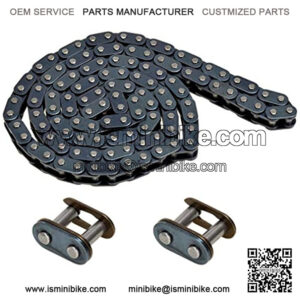1. Know How Many Links Are in The Chain
In order to count the links in a chain, you first need to know how many links are in the chain. The best way to do this is to look at the manufacturer’s specifications or the owner’s manual. If you don’t have either of those, you can try to find out by looking online or contacting the company directly.
2. Inspect the Entire Chain for Any Damage or Wear
Before you start counting links, it’s important to inspect the entire chain for any damage or wear. This is especially important if you’re going to be cutting the chain. You don’t want to cut a link that’s already damaged, as this could cause the chain to break.
3. Find out The Gauge, or Thickness, of The Chain
A chain’s gauge, or thickness, is an important factor in determining how much weight it can hold. If you’re unsure what gauge your chain is, you can look at the manufacturer’s specifications or the owner’s manual. Alternatively, you can measure the thickness of the chain with a ruler or caliper.
4. Determine How Much Weight the Chain Can Hold
Another important factor in counting links in a chain is determining how much weight the chain can hold. This information can usually be found in the manufacturer’s specifications or the owner’s manual. If you’re not sure, it’s always better to err on the side of caution and assume that the chain can’t hold as much weight as you think.
5. Choose a Method to Count the Links Using a Printable Link Chart
One of the simplest ways to count links in a chain is to use a printable link chart. These charts are free online and can be printed on a regular printer. To use one of these charts, simply line up the first link of the chain with the start of the chart and count how many links there are in the chain.
6. Use a Digital Link Counter or An App on A Smartphone
If you want to be more precise when counting links in a chain, you can use a digital link counter. These devices are relatively inexpensive and can be found online or at some hardware stores. Alternatively, some apps can be downloaded onto a smartphone that will count links for you.
7. Always Count the Links in A Chain Before Cutting Them
If you’re going to be cutting the links in a chain, it’s important always to count the links first. This way, you can ensure you’re not cutting any damaged or worn links. Additionally, counting the links before you cut them will also ensure that you have enough links to put the chain back together again.
That’s it! You’ve now learned how to count links in a chain. Just remember to always inspect the chain for damage or wear before you start counting, and be sure to count the links before you cut them.
Why It’s Important to Counting Links in A Chain
Anyone who has ever worked with a chain knows that it is important to be able to count the links. After all, if one link is broken, the entire chain is useless. However, beyond simply being able to function, there are other reasons why counting links in a chain is important.
For example, when buying a new chain, you must know how many links you need to get the right size. In addition, if you are repairing a broken chain, you need to know how many links are in the chain to determine where the break occurred.
Furthermore, if you are adding new links to a chain, you again need to know how many links there are to ensure that the new links fit properly. As this shows, there are a variety of situations in which it is important to know how to count links in a chain. Without this knowledge, maintaining or repairing a chain would be difficult.
How to Quickly and Easily Count Links in A Chain
Whether you’re making a necklace or constructing a piece of jewelry, it’s important to be able to quickly and easily count links in a chain. Fortunately, there is a simple method that can be used for both counting and measuring. To start, gather the chain and a ruler. Then, use the ruler to measure out one foot of the chain.
Once you have your measurement, count the number of links within that one-foot section. This will give you the link-per-inch ratio. Then, to get the total number of links in the chain, simply multiply the link-per-inch ratio by 12 (the number of inches in a foot). This method is easy to follow and requires no special tools, making it ideal for counting links in a hurry.
What Are Some of The Benefits of Counting Links in A Chain?
There are many benefits to counting links in a chain, especially regarding safety. For example, if you’re working with a chain saw, it’s important to know how many links are in the chain to tension it properly. Too loose can come off the saw and cause serious injury if the chain is too loose. Likewise, if the chain is too tight, it can break and also cause injury. In both cases, counting links can help prevent accidents.
In addition to safety, counting links can also be helpful for maintenance and repairs. For example, if a link breaks, you’ll need to know how many there are to replace it with an identical one. And if you’re making any adjustments to the chain, such as lengthening or shortening it, you’ll need to know the total number of links so that you don’t throw off the tension or balance. So, as you can see, there are many good reasons to habitually count links in a chain, whether for safety, maintenance, or repairs.
About minibike chain link
“35 chain master link”
“mini bike chains”
“35 chain master link near me”
“mini bike chain size”
“mini bike chain size 35”
“420 mini bike chain”


